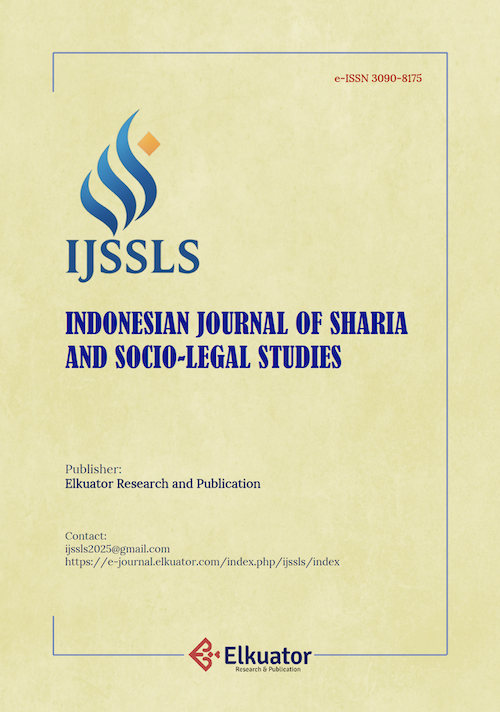Power Relations and Structural Inequality in Late-Life Divorce: A Socio-Legal Analysis of the Palembang Islamic Court Decisions in 2022
DOI:
https://doi.org/10.24260/ijssls.1.1.16Keywords:
Islamic Courts, Late-Life Divorce, Legal Reasoning, Power Relations, Structural InequalityAbstract
The increasing incidence of divorce among older couples signifies a notable shift in both the social structure and the legal framework of family law in Indonesia. While long-term marriages are typically associated with emotional stability and strong commitment, data from the Palembang Islamic Court indicate that individuals aged 56 and older remain susceptible to marital dissolution. This article aims to analyze the typology of causes behind late-life divorce and examine the legal reasoning employed by Muslim judges in adjudicating such cases. Adopting a socio-legal approach, the study integrates empirical data with a jurisprudential analysis of 56 divorce decisions issued by the Palembang Islamic Court in 2022. The findings reveal that late-life divorce does not occur abruptly; rather, it is the culmination of long-standing, structurally embedded conflicts, including domestic violence, economic subordination, and inequality in emotional and sexual relations. Furthermore, the study demonstrates that the judicial reasoning of Muslim judges is not entirely neutral; it reflects the internalization of prevailing social norms and institutionalized power relations within the adjudicative process. Accordingly, this article argues that late-life divorce should not be perceived merely as a personal failure but as a manifestation of gender-based structural inequality operating across two primary domains: the domestic and the institutional. Thus, the study calls for a reformulation of Islamic legal approaches and the development of a more gender-responsive religious court system capable of addressing structural disparities in the context of elderly divorce.
[Fenomena meningkatnya angka perceraian pada pasangan usia lanjut menandai pergeseran penting dalam struktur sosial dan konfigurasi hukum keluarga di Indonesia. Meskipun pernikahan jangka panjang sering diasosiasikan dengan stabilitas emosional dan komitmen yang kuat, data dari Pengadilan Agama Palembang menunjukkan bahwa pasangan berusia 56 tahun ke atas tetap berada dalam kondisi rentan terhadap perceraian. Artikel ini bertujuan untuk menganalisis tipologi penyebab perceraian usia lanjut dan mengkaji konstruksi argumentasi hukum yang digunakan oleh hakim muslim dalam memutus perkara, melalui pendekatan sosio-legal yang mengintegrasikan studi lapangan dengan analisis yurisprudensi terhadap 56 putusan Pengadilan Agama Palembang tahun 2022. Hasil penelitian menunjukkan bahwa perceraian pada usia lanjut tidak terjadi secara tiba-tiba, melainkan merupakan akumulasi konflik jangka panjang yang bersifat struktural, termasuk kekerasan domestik, subordinasi ekonomi, serta ketimpangan dalam relasi seksual dan emosional. Temuan ini juga memperlihatkan bahwa argumentasi hukum hakim muslim dalam memutus perkara tidak sepenuhnya bersifat netral, tetapi turut mencerminkan internalisasi norma sosial dan struktur relasi kuasa yang terlembaga dalam sistem peradilan. Dengan demikian, artikel ini menegaskan bahwa perceraian usia lanjut bukan sekadar kegagalan relasi personal, melainkan perlu dipahami sebagai manifestasi dari ketidaksetaraan gender yang beroperasi dalam dua arena utama: domestik dan institusional. Oleh karena itu, diperlukan reformulasi pendekatan hukum Islam dan penguatan sistem peradilan agama yang lebih responsif terhadap dimensi ketimpangan struktural berbasis gender dalam konteks perceraian lansia.]
References
Abbasi, Muhammad Zubair. “Judicial Ijtihād as a Tool for Legal Reform: Extending Women’s Right to Divorce under Islamic Law in Pakistan.” Islamic Law and Society 24, no. 4 (October 3, 2017): 384–411. https://doi.org/10.1163/15685195-00244P04.
Ajhuri, Kayyis Fithri. Psikologi Perkembangan: Pendekatan Sepanjang Rentang Kehidupan. Yogyakarta: Penebar Media Pustaka, 2019.
Akter, Maksuda, and Roquia Begum. “Factors for Divorce of Women Undergoing Divorce in Bangladesh.” Journal of Divorce & Remarriage 53, no. 8 (November 2012): 639–51. https://doi.org/10.1080/10502556.2012.725364.
Al Amin, Muchammad. “Klasifikasi Kelompok Umur Manusia Berdasarkan Analisis Dimensifraktal Box Counting dari Citra Wajah dengan Deteksi Tepi Canny.” MATHunesa 2, no. 6 (2017): 33–42.
Ali, Moh. “Measuring Ex Officio Judge Rights and Application of the Ultra Petitum Partium Principle in Deciding Cases in Religious Courts.” Journal of Law and Legal Reform 5, no. 1 (January 31, 2024): 383–408. https://doi.org/10.15294/jllr.vol5i1.2314.
Andar Yuni, Lilik. “The Use of Ex Officio to Fulfill Women’s Post-Divorce Rights at the Samarinda Religious Court.” Ijtihad: Jurnal Wacana Hukum Islam dan Kemanusiaan 21, no. 2 (December 29, 2021): 135–54. https://doi.org/10.18326/ijtihad.v21i2.135-154.
Asman, Asman, and Resali bin Muda. “Social Dynamics on the Increasing Divorce of Malay Communities during COVID-19 in Sambas West Kalimantan, Indonesia Perspective of Islamic Family Law.” Al-Manahij: Jurnal Kajian Hukum Islam 17, no. 2 (August 23, 2023): 153–66. https://doi.org/10.24090/mnh.v17i2.8235.
Asni. “The Mashlahah Consideration in Divorce Cases Caused by Domestic Violence in Religious Court.” Ahkam: Jurnal Ilmu Syariah 14, no. 1 (2014): 105–14. https://doi.org/10.15408/ajis.v14i1.1247.
Brown, S. L., and I.-F. Lin. “The Gray Divorce Revolution: Rising Divorce Among Middle-Aged and Older Adults, 1990-2010.” The Journals of Gerontology Series B: Psychological Sciences and Social Sciences 67, no. 6 (November 1, 2012): 731–41. https://doi.org/10.1093/geronb/gbs089.
Brown, Susan L, and I-Fen Lin. “The Graying of Divorce: A Half Century of Change.” Edited by Zhen Cong. The Journals of Gerontology: Series B 77, no. 9 (September 1, 2022): 1710–20. https://doi.org/10.1093/geronb/gbac057.
Cecchi, S., and P. Beffa Negrini. “The Grey Divorce: An Unknown and Growing Up Reality.” Giornale Di Gerontologia 53, no. 5 (2005): 555–59.
Dall’Agnola, Jasmin, and Hélène Thibault. “Online Temptations: Divorce and Extramarital Affairs in Kazakhstan.” Religions 12, no. 8 (August 2021): 654. https://doi.org/10.3390/rel12080654.
“Directory of Decisions of the Supreme Court of Indonesia.” Accessed March 19, 2023. https://putusan3.mahkamahagung.go.id/search.html?q=&jenis_doc=&cat=&jd=&tp=0&court=402242PA683+++++++++++++++++++++&t_put=2022&t_reg=&t_upl=&t_pr.
Djawas, Mursyid, Ridhwan Ridhwan, Soraya Devy, and Asmaul Husna. “The Government’s Role in Decreasing Divorce Rates in Indonesia: A Study of Its Factors and Impacts in Aceh and South Sulawesi.” AHKAM: Jurnal Ilmu Syariah 21, no. 1 (June 30, 2021): 163–88. https://doi.org/10.15408/ajis.v21i1.20870.
Donnelly, Rachel. “Job Insecurity as a Predictor of Gray Divorce: A Gendered Dyadic Analysis.” Social Forces 103, no. 3 (January 13, 2025): 928–47. https://doi.org/10.1093/sf/soae097.
Faiz, Abd Karim, Zulfahmi Ar, and Ahmad Izzuddin. “Between State Law and Islamic Law: The Practice of Divorce Outside the Situbondo Religious Courts, Indonesia.” Journal of Islamic Law 3, no. 2 (August 31, 2022): 176–92. https://doi.org/10.24260/jil.v3i2.848.
“Government Regulation No. 9 of 1975 on the Implementation of Law No. 1 of 1974 on Marriage.” Accessed March 28, 2025. http://peraturan.bpk.go.id/Details/67678/pp-no-9-tahun-1975.
Harahap, Haddad Ulum, Muhammad Fadhlan Is, Amrar Mahfuzh Faza, and Muhamad Hasan Sebyar. “Legal Status of a Wife Leaving Her Husband and Vice Versa in Contextual Fiqh Studies: A Pre-Divorce Analysis.” Jurnal Ilmiah Mizani: Wacana Hukum, Ekonomi Dan Keagamaan 12, no. 1 (April 16, 2025): 50–63. https://doi.org/10.29300/mzn.v12i1.7158.
Hartini, Hartini, Haniah Ilhami, and Rahmawati Mohd Yusoff. “Sole Custody and the Implication of Fault-Based Divorce Under the Indonesian Legal System.” Journal of Indonesian Legal Studies 9, no. 1 (May 8, 2024): 249–78. https://doi.org/10.15294/jils.vol9i1.4576.
Heaton, Tim, and Mark Cammack. “Explaining the Recent Upturn in Divorce in Indonesia: Developmental Idealism and the Effect of Political Change.” Asian Journal of Social Science 39, no. 6 (2011): 776–96. https://doi.org/10.1163/156853111X619229.
Heim, Christian, and Caroline Heim. “‘How Did You Stay Together So Long?’ Relationship Longevity, a Cross‐Generational Qualitative Study.” Journal of Marital and Family Therapy 49, no. 4 (October 2023): 781–801. https://doi.org/10.1111/jmft.12656.
Hermanto, Agus. Problematika Hukum Keluarga Islam di Indonesia. Malang: CV Literasi Nusantara Abadi, 2021.
Husin, Asna. “Falling Out of Love: Divorce of Three Acehnese Ubanan Couples in the Islamic Law Perspective.” Samarah: Jurnal Hukum Keluarga dan Hukum Islam 7, no. 3 (November 30, 2023): 1868–96. https://doi.org/10.22373/sjhk.v7i3.19433.
Jones, Gavin W. “Divorce in Malaysia: Historical Trends and Contemporary Issues.” Jurnal Institutions and Economies 13, no. 4 (October 1, 2021): 35–60. https://doi.org/10.22452/IJIE.vol13no4.2.
———. “Modernization and Divorce: Contrasting Trends in Islamic Southeast Asia and the West.” Population and Development Review 23, no. 1 (March 1997): 95–114. https://doi.org/10.2307/2137462.
Jones, Gavin Willis. “Muslim and Non-Muslim Divorce Trends in Southeast Asia in the 21st Century.” Asian Journal of Social Science 51, no. 3 (September 2023): 137–45. https://doi.org/10.1016/j.ajss.2023.04.004.
Karimi, Reza, Maryam Bakhtiyari, and Abbas Masjedi Arani. “Protective Factors of Marital Stability In Long-Term Marriage Globally: A Systematic Review.” Epidemiology and Health 41 (June 15, 2019): e2019023. https://doi.org/10.4178/epih.e2019023.
Latifah, Luluk, and Iskandar Ritonga. “Difference of Divorce Determination in Indonesia: A Study Systematic Literature Review.” Jurnal Biometrika dan Kependudukan 11, no. 02 (November 1, 2022): 223–35. https://doi.org/10.20473/jbk.v11i02.2022.223-235.
“Law No. 1 of 1974 on Marriage.”
Lekat. Interview with a Judge of the Palembang Islamic Court, April 4, 2022.
Lin, I-Fen, Susan L Brown, Matthew R Wright, and Anna M Hammersmith. “Antecedents of Gray Divorce: A Life Course Perspective.” The Journals of Gerontology: Series B 73, no. 6 (August 14, 2018): 1022–31. https://doi.org/10.1093/geronb/gbw164.
Makinara, Ihdi Karim, Jamhuri Ungel, and Fitrah Arrazi. “Physical Handicap as a Reason for Divorce: Case Study at the Sharia Court, Banda Aceh, Indonesia.” El-Usrah: Jurnal Hukum Keluarga 6, no. 2 (December 30, 2023): 318–34. https://doi.org/10.22373/ujhk.v6i2.7836.
Monin, Joan K., Gail McAvay, Emma Zang, Brent Vander Wyk, Carmen I. Carrión, and Heather Allore. “Associations between Dementia Staging, Neuropsychiatric Behavioral Symptoms, And Divorce or Separation in Late Life: A Case Control Study.” Edited by Ashish Sarangi. PLOS ONE 18, no. 8 (August 16, 2023): e0289311. https://doi.org/10.1371/journal.pone.0289311.
Nisa, Martina Purna. “Critical Review of Domestic Violence as Reason for Divorce (Comparison of Divorce Laws in Indonesia, Malaysia and the Maldives).” AL-IHKAM: Jurnal Hukum & Pranata Sosial 16, no. 1 (June 22, 2021): 1–23. https://doi.org/10.19105/al-lhkam.v16i1.4292.
Nofiardi, Nofiardi. “Testimonium de Auditu Witness: Comparison of Maṣlāhah in the Settlement of Syiqāq in the Religious Court of the Border Regions.” Samarah: Jurnal Hukum Keluarga dan Hukum Islam 7, no. 2 (June 5, 2023): 1016–36. https://doi.org/10.22373/sjhk.v7i2.11493.
Nurlaelawati, Euis. “Muslim Women in Indonesian Religious Courts.” Islamic Law and Society 20, no. 3 (2013): 242–71. https://doi.org/10.1163/15685195-0010A0003.
Nursaidah, Nursaidah, Adi Nur Rohman, and Panti Rahayu. “The Out of Court Divorce Model and Its Legal Implications: A Juridical Study in Babelan District Bekasi.” Syariah: Jurnal Hukum Dan Pemikiran 20, no. 2 (December 14, 2020): 159–74. https://doi.org/10.18592/sjhp.v20i2.3945.
“Palembang Islamic Court Decision No. 1222/Pdt.G/2022/PA.PLG.”
“Palembang Islamic Court Decision No. 1510/Pdt.G/2022/PA.PLG.”
“Palembang Islamic Court Decision No. 1546/Pdt.G/2022/PA.PLG.”
“Palembang Islamic Court Decision No. 1696/Pdt.G/2022/PA.PLG.”
“Palembang Islamic Court Decision No. 1703/Pdt.G/2022/PA.PLG.”
“Palembang Islamic Court Decision No. 2061/Pdt.G/2022/PA.PLG.”
“Palembang Islamic Court Decision No. 2219/Pdt.G/2022/PA.PLG.”
“Palembang Islamic Court Decision No. 2593/Pdt.G/2022/PA.PLG.”
“Palembang Islamic Court Decision No. 2740/Pdt.G/2022/PA.PLG.”
“Presidential Instruction No. 1 of 1991 on the Compilation of Islamic Law.”
Rachman, S.M.A., and H. Ali. “Divorce Without In-Between: An Empirical Study on the Failure of Mediation in the Religious Court of Sengeti Jambi Province.” Man in India 96, no. 11 (2016): 4209–24.
Ramadhita, Ramadhita, Mahrus Ali, and Bachri Syabbul. “Gender Inequality and Judicial Discretion in Muslims Divorce of Indonesia.” Cogent Social Sciences 9, no. 1 (December 31, 2023): 2206347. https://doi.org/10.1080/23311886.2023.2206347.
Rinaldo, Rachel, Eva F. Nisa, and Nina Nurmila. “Divorce Narratives and Class Inequalities in Indonesia.” Journal of Family Issues 45, no. 5 (May 2024): 1195–1216. https://doi.org/10.1177/0192513X231155657.
Rohmadi, Rohmadi. “Polygamy in Indonesia: A Critical Interpretation through the Lens of Mubadalah Theory.” Jurnal Ilmiah Mizani: Wacana Hukum, Ekonomi dan Keagamaan 11, no. 2 (October 15, 2024): 378–90. https://doi.org/10.29300/mzn.v11i2.5068.
Rusyidi. Interview with a Judge of the Palembang Islamic Court, April 10, 2022.
Sanjaya, Umar Haris, and Aunur Rahim Faqih. Hukum Perkawinan Islam di Indonesia. Yogyakarta: Gama Media, 2017.
Schober, Pia S. “Gender Equality and Outsourcing of Domestic Work, Childbearing, and Relationship Stability Among British Couples.” Journal of Family Issues 34, no. 1 (January 2013): 25–52. https://doi.org/10.1177/0192513x11433691.
Shesa, Laras, Muhammad Abu Dzar, Elkhairati, and Henny Septia Utami. “Reformulating Progressive Fiqh of Talak (Divorce): A Contemporary Study of the Principle of Making Divorce More Difficult in SEMA No. 1 of 2022 for Women’s Protection.” MILRev: Metro Islamic Law Review 3, no. 2 (December 13, 2024): 236–62. https://doi.org/10.32332/milrev.v3i2.9950.
Shrout, M. Rosie, Stephanie J. Wilson, Megan E. Renna, Annelise A. Madison, and Janice K. Kiecolt-Glaser. “‘We’ve Got This’: Middle-Aged and Older Couples’ Satisfying Relationships and We-Talk Promote Better Physiological, Relational, and Emotional Responses to Conflict.” Psychosomatic Medicine 85, no. 2 (February 2023): 154–64. https://doi.org/10.1097/PSY.0000000000001162.
Sirjoni. Interview with a Judge of the Palembang Islamic Court, April 10, 2022.
Sudirman. Pisah Demi Sakinah Kajian Kasus Mediasi Perceraian di Pengadilan Agama. Jember: Pustaka Radja, 2018.
Sulaeman, Otong, Dodon Alfiander, Oktari Kanus, Sri Nur Rahmi, and Bekti Utomo. “Negotiating Gender Justice in Minangkabau Marital Disputes: Between Adat, Islamic, and State Law.” Juris: Jurnal Ilmiah Syariah 24, no. 1 (2025): 39–49. https://doi.org/10.31958/juris.v24i1.11848.
Sunarsi, Dessy, Yuherman, and Sumiyati. “Effectiveness of Mediation Implementations in the Religious Courts of Indonesia.” International Journal of Innovation, Creativity and Change 10, no. 3 (2019): 49–64.
“Supreme Court Regulation No. 1 of 2016 on Court Mediation Procedures.” Accessed March 28, 2025. http://peraturan.bpk.go.id/Details/209641/perma-no-1-tahun-2016.
Sururie, Ramdani Wahyu, Mohammad Athoillah, and Muhammad Iqbal Zia Ulhaq. “Strategies to Prevent Increasing Divorce Rates for Muslim Families in Indonesia.” Samarah: Jurnal Hukum Keluarga dan Hukum Islam 7, no. 2 (May 9, 2023): 734–59. https://doi.org/10.22373/sjhk.v7i2.14819.
Syazili. Interview with a Judge of the Palembang Islamic Court, April 10, 2022.
Taylor, Larry W. “The Transition to Mid-Life Divorce.” Review of Economics of the Household 9, no. 2 (June 2011): 251–71. https://doi.org/10.1007/s11150-009-9063-8.
Van Huis, Stijn Cornelis. “Khul‘ Over the Longue Durée: The Decline of Traditional Fiqh-Based Divorce Mechanisms in Indonesian Legal Practice.” Islamic Law and Society 26, no. 1–2 (January 1, 2019): 58–82. https://doi.org/10.1163/15685195-00254A05.
Vu, Ha Song, Sidney Schuler, Tu Anh Hoang, and Trang Quach. “Divorce in the Context of Domestic Violence Against Women in Vietnam.” Culture, Health & Sexuality 16, no. 6 (July 3, 2014): 634–47. https://doi.org/10.1080/13691058.2014.896948.
Wahyudi, Muhammad Isna. “Women Dealing with the Law in Religious Courts.” AHKAM: Jurnal Ilmu Syariah 18, no. 2 (July 12, 2018): 305–20. https://doi.org/10.15408/ajis.v18i2.7491.
Walby, Sylvia. Theorizing Patriarchy. Oxford, UK ; Cambridge, MA, USA: Wiley-Blackwell, 1991.
Weber, Elisa, and Gizem Hülür. “The Role of Relationship Conflict for Momentary Loneliness and Affect in the Daily Lives of Older Couples.” Journal of Social and Personal Relationships 40, no. 7 (July 2023): 2033–60. https://doi.org/10.1177/02654075221138022.
Zulkarnain, Alice, and Sanders Korenman. “Divorce and Health in Middle and Older Ages.” Review of Economics of the Household 17, no. 4 (December 2019): 1081–1106. https://doi.org/10.1007/s11150-018-9435-z.
Downloads
Published
Issue
Section
License
Copyright (c) 2025 Ellis Lindini Putri, Ari Azhari, Rahmat Abdullah, Muhammad Husni

This work is licensed under a Creative Commons Attribution-NonCommercial 4.0 International License.















